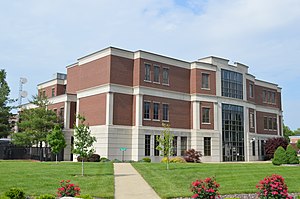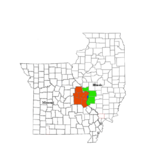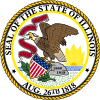Clinton County, Illinois
Clinton County | |
|---|---|
U.S. county | |
 | |
 Location within the U.S. state of Illinois | |
 Illinois's location within the U.S. | |
| Coordinates: 38°37′N 89°25′W / 38.61°N 89.42°W | |
| Country | |
| State | |
| Founded | 1824 |
| Named for | DeWitt Clinton |
| Seat | Carlyle |
| Largest city | Breese |
| Area | |
| • Total | 503 sq mi (1,300 km2) |
| • Land | 474 sq mi (1,230 km2) |
| • Water | 29 sq mi (80 km2) 5.8% |
| Population (2010) | |
| • Total | 37,762 |
| • Estimate (2019) | 37,562 |
| • Density | 75/sq mi (29/km2) |
| Time zone | UTC−6 (Central) |
| • Summer (DST) | UTC−5 (CDT) |
| Congressional district | 15th |
| Website | www |
Clinton County is located in the U.S. state of Illinois. As of the 2010 United States Census, the population was 37,762.[1] Its county seat is Carlyle.[2]
In 1960, the United States Census Bureau placed the mean center of U.S. population in Clinton County.[3]
Clinton County is part of the St. Louis, MO-IL Metropolitan Statistical Area.
History[]
This section needs expansion. You can help by . (September 2011) |
In 1805, prior to the establishment of the county, the territorial government established a post road from its capital (Vincennes, Indiana) to St. Louis, Missouri, passing through the county.[4] In 1808 a wagon road was laid out through the future Clinton County. It extended from the Goshen Settlement to the Ohio salt works and crossed the Kaskaskia River at Carlyle.[5]
Clinton County was created on 27 December 1824, from portions of Washington, Fayette, and Bond Counties. It was named for the seventh Governor of New York, DeWitt Clinton, who helped build the Erie Canal.[6]
Crossing the Kaskaskia became much easier when the bridge now known as the General Dean Suspension Bridge was built in 1859, at a cost of $40,000.[7] Before the bridge was constructed, crossings involved a ferry or a mud bridge.[8][9] The Illinois General Assembly set aside $20,000 for bridge restoration in 1951, and in 1953 the bridge was named after William F. Dean.[7]
Geography[]
According to the U.S. Census Bureau, the county has a total area of 503 square miles (1,300 km2), of which 474 square miles (1,230 km2) is land and 29 square miles (75 km2) (5.8%) is water.[10] Eldon Hazlet State Recreation Area and South Shore State Park are in Clinton County. Its southern border is the Kaskaskia River.
Climate and weather[]
| Carlyle, Illinois | ||||||||||||||||||||||||||||||||||||||||||||||||||||||||||||
|---|---|---|---|---|---|---|---|---|---|---|---|---|---|---|---|---|---|---|---|---|---|---|---|---|---|---|---|---|---|---|---|---|---|---|---|---|---|---|---|---|---|---|---|---|---|---|---|---|---|---|---|---|---|---|---|---|---|---|---|---|
| Climate chart (explanation) | ||||||||||||||||||||||||||||||||||||||||||||||||||||||||||||
| ||||||||||||||||||||||||||||||||||||||||||||||||||||||||||||
| ||||||||||||||||||||||||||||||||||||||||||||||||||||||||||||
In recent years, average temperatures in the county seat of Carlyle have ranged from a low of 19 °F (−7 °C) in January to a high of 88 °F (31 °C) in July, although a record low of −22 °F (−30 °C) was recorded in January 1994 and a record high of 104 °F (40 °C) was recorded in July 1980. Average monthly precipitation ranged from 2.17 inches (55 mm) in January to 4.44 inches (113 mm) in June.[11]
Major highways[]
 Interstate 64
Interstate 64 US Route 50
US Route 50 Illinois Route 127
Illinois Route 127 Illinois Route 160
Illinois Route 160 Illinois Route 161
Illinois Route 161 Illinois Route 177
Illinois Route 177
Adjacent counties[]
- Bond County - north
- Fayette County - northeast
- Madison County - northwest
- Marion County - east
- St. Clair County - west
- Washington County - south
Demographics[]
| Historical population | |||
|---|---|---|---|
| Census | Pop. | %± | |
| 1830 | 2,330 | — | |
| 1840 | 3,718 | 59.6% | |
| 1850 | 5,139 | 38.2% | |
| 1860 | 10,941 | 112.9% | |
| 1870 | 16,285 | 48.8% | |
| 1880 | 18,714 | 14.9% | |
| 1890 | 17,411 | −7.0% | |
| 1900 | 19,824 | 13.9% | |
| 1910 | 22,832 | 15.2% | |
| 1920 | 22,947 | 0.5% | |
| 1930 | 21,369 | −6.9% | |
| 1940 | 22,912 | 7.2% | |
| 1950 | 22,594 | −1.4% | |
| 1960 | 24,029 | 6.4% | |
| 1970 | 28,315 | 17.8% | |
| 1980 | 32,617 | 15.2% | |
| 1990 | 33,944 | 4.1% | |
| 2000 | 35,535 | 4.7% | |
| 2010 | 37,762 | 6.3% | |
| 2019 (est.) | 37,562 | [12] | −0.5% |
| US Decennial Census[13] 1790-1960[14] 1900-1990[15] 1990-2000[16] 2010-2013[1] | |||

As of the 2010 United States Census, there were 37,762 people, 14,005 households, and 9,760 families residing in the county.[17] The population density was 79.7 inhabitants per square mile (30.8/km2). There were 15,311 housing units at an average density of 32.3 per square mile (12.5/km2).[10] The racial makeup of the county was 93.4% white, 3.5% black or African American, 0.4% Asian, 0.2% American Indian, 1.2% from other races, and 1.1% from two or more races. Those of Hispanic or Latino origin made up 2.8% of the population. In terms of ancestry, 54.8% were German, 9.8% were Irish, 5.8% were English, and 5.6% were American.[18]
Of the 14,005 households, 32.7% had children under the age of 18 living with them, 56.5% were married couples living together, 8.7% had a female householder with no husband present, 30.3% were non-families, and 25.1% of all households were made up of individuals. The average household size was 2.55 and the average family size was 3.02. The median age was 39.3 years.
The median income for a household in the county was $55,278 and the median income for a family was $66,682. Males had a median income of $45,119 versus $34,051 for females. The per capita income for the county was $25,392. About 5.2% of families and 7.8% of the population were below the poverty line, including 9.2% of those under age 18 and 5.7% of those age 65 or over.[19]
Education[]
- Carlyle Community Unit School District 1
- Patoka Community Unit School District 100
- Sandoval Community Unit School District 501
- Wesclin Community Unit School District 3
- Central Community High School, Breese
- Mater Dei Catholic High School, Breese
Communities[]
Cities[]
Villages[]
- Albers
- Aviston
- Bartelso
- Beckemeyer
- Damiansville
- Germantown
- Hoffman
- Huey
- Keyesport (part)
- New Baden (part)
- Saint Rose
- Shattuc
Townships[]
Unincorporated Communities[]
Politics[]
As part of German Catholic Central Illinois, nineteenth-century Clinton County was opposed to the “Yankee” Civil War and the Northern Illinois residents who supported it and the Republican Party. Consequently, the county was solidly Democratic for the six decades after the Civil War, turning Republican only due to opposition to Woodrow Wilson’s post-World War I policies towards Germany. Its first flirt with Republicanism was short-lived: in 1924 Clinton was the nation's southeasternmost county – and the solitary one in Illinois – to give a plurality to Robert M. La Follette, and in 1928 its residents voted powerfully for coreligionist Al Smith despite a landslide loss nationally.
1936, despite a landslide win for Franklin D. Roosevelt, saw Clinton County, like many other German Catholic counties in the Midwest, show a more permanent trend away from the Democratic Party: owing to a strong vote for Union Party candidate William Lemke, Roosevelt only won a plurality, and with powerful local opposition to World War II Wendell Willkie and Thomas E. Dewey won over 62 percent of the county's vote in the two elections held whilst World War II was in progress. Since then only Catholic John F. Kennedy and Lyndon B. Johnson during his 1964 landslide have obtained a majority in the county for the Democratic Party, although Bill Clinton did win pluralities in both 1992 and 1996. In the 2016 United States presidential election, Donald Trump won the county against Hillary Clinton by 48.6 percent in 2016 – the worst performance ever by a Democrat.[citation needed]
See also[]
- National Register of Historic Places listings in Clinton County, Illinois
References[]
- Specific
- ^ Jump up to: a b "State & County QuickFacts". US Census Bureau. Archived from the original on July 14, 2014. Retrieved July 4, 2014.
- ^ "Find a County". National Association of Counties. Archived from the original on May 31, 2011. Retrieved June 7, 2011.
- ^ "Mean Center of Population for the United States: 1790 to 2000" (PDF). US Census Bureau. Archived from the original (PDF) on November 3, 2001. Retrieved September 17, 2011.
- ^ Douglas K. Meyer (2000). Making the Heartland Quilt. SIU Press. p. 58. ISBN 0-8093-2289-7. Retrieved September 11, 2011.
- ^ 1913 Commercial History of Clinton County, Illinois Archived 23 July 2011 at the Wayback Machine from clinton.ilgenweb.net. Retrieved 10 November 2010
- ^ Allan H. Keith, Historical Stories: About Greenville and Bond County, IL. Retrieved August 15, 2007.
- ^ Jump up to: a b Attractions & Outdoor Recreation Archived 7 February 2007 at the Wayback Machine, City of Carlyle, Official site
- ^ "Suspension Bridge, Spanning Kaskaskia River, Carlyle, Clinton, IL". Historic American Buildings Survey. Library of Congress. Archived from the original on October 2, 2012. Retrieved September 11, 2011.
- ^ Plaque on site, Photograph of plaque at Bridgemeister Archived 27 September 2007 at the Wayback Machine.
- ^ Jump up to: a b "Population, Housing Units, Area, and Density: 2010 - County". US Census Bureau. Archived from the original on February 12, 2020. Retrieved July 11, 2015.
- ^ Jump up to: a b "Monthly Averages for Carlyle IL". The Weather Channel. Archived from the original on October 23, 2012. Retrieved January 27, 2011.
- ^ "County Population Totals: 2010-2019". Retrieved March 3, 2021.
- ^ "US Decennial Census". US Census Bureau. Retrieved July 4, 2014.
- ^ "Historical Census Browser". University of Virginia Library. Archived from the original on December 26, 2013. Retrieved July 4, 2014.
- ^ "Population of Counties by Decennial Census: 1900 to 1990". US Census Bureau. Archived from the original on April 24, 2014. Retrieved July 4, 2014.
- ^ "Census 2000 PHC-T-4. Ranking Tables for Counties: 1990 and 2000" (PDF). US Census Bureau. Archived (PDF) from the original on December 18, 2014. Retrieved July 4, 2014.
- ^ "Profile of General Population and Housing Characteristics: 2010 Demographic Profile Data". US Census Bureau. Archived from the original on February 13, 2020. Retrieved July 11, 2015.
- ^ "Selected Social Characteristics in the United States – 2006-2010 American Community Survey 5-Year Estimates". US Census Bureau. Archived from the original on February 13, 2020. Retrieved July 11, 2015.
- ^ "Selected Economic Characteristics – 2006-2010 American Community Survey 5-Year Estimates". US Census Bureau. Archived from the original on February 13, 2020. Retrieved July 11, 2015.
- ^ Leip, David. "Dave Leip's Atlas of U.S. Presidential Elections". uselectionatlas.org. Archived from the original on March 23, 2018. Retrieved May 1, 2018.
- General
External links[]
 Media related to Clinton County, Illinois at Wikimedia Commons
Media related to Clinton County, Illinois at Wikimedia Commons- Official website
- Clinton County IL Genealogy Web Project
- Illinois counties
- Clinton County, Illinois
- 1824 establishments in Illinois
- Southern Illinois
- Metro East
- Populated places established in 1824




